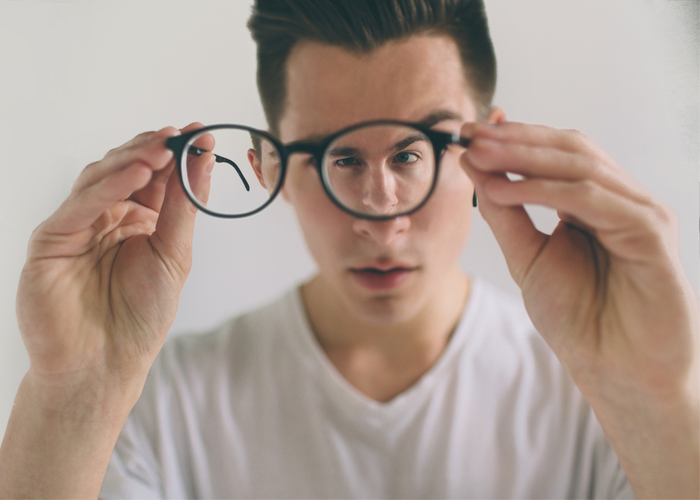
Myopia, commonly known as shortsightedness or nearsightedness, is a very common vision problem that causes distant objects to appear blurry. Around one third of Australians are myopic, and the incidents of myopia in Australia are increasing dramatically, with studies pointing towards 55% of Australians being myopic by 2050.
People with myopia will commonly be able to see close objects clearly and, before diagnosis and corrective measures are taken, may experience headaches and eye strain when trying to focus on distant objects. Uncorrected myopia in children can lead to related eye problems like a lazy eye or omnipresent squint. The condition usually begins in childhood and is not self-correcting.
What Causes Myopia?
In a normal eye, light enters through the cornea and is focussed on the retina at the back of the eye. Due to the shape of the eye or ability of the cornea to focus light, the image is formed in front of the retina, limiting what can clearly be seen. Outside of the direct mechanical cause of the condition, there is no firm consensus on what causes the condition to develop. There is some belief that constant close focus - working on screens (computers, phones and tablets) reading and other close work could condition the eye to focus solely on close distance. Genetics also plays a part in myopia. People with a parent with myopia are more likely to have the condition.
A theory as to why the condition worsens throughout life points to what is called “peripheral defocus”. Without getting into in depth medical and scientific detail, the idea is that traditional lenses cause light to be focussed more through the macula, leading to clear central vision but slightly blurry peripheral vision, and this lack of focus on the periphery leads to the condition worsening with age.
If you’re having trouble seeing things at a distance and need an eye test, the easiest way to find and book an appointment with an optometrist near you is through MyHealth1st.
Diagnosing Myopia
The symptoms of myopia are fairly obvious - a difficulty seeing things at range. The maximum distance a person can see clearly varies from person to person and is measured in “dioptres”, units of refractive power. A person with normal vision will require around 60 dioptres to be able to see objects in the distance. Someone with myopia requires more units of power to focus, so someone with 61 dioptres (-1.00D, or minus one dioptres) could function quite normally for the most part but would require correction for distance vision. The more dioptres needed to focus on long range, the worse the myopia. At -5.00D, a person would need constant correction to do anything other than see things at very close range. Mild myopia is measured between -0.25D and -3.00D, and high (severe) myopia is anything over -6.00D.
Children with myopia may have trouble reading the board at school, be reticent to play sports and outdoor games or constantly squint. It’s recommended that children have regular eye exams throughout their school years.
The main downside of myopia is requiring glasses or contact lenses to maintain clear sight at a distance away from you. But what isn’t always understood is that the more myopic you are, the more at risk you are of degenerative health changes in your eyes in adulthood. Myopic people are more at risk for conditions such as glaucoma , cataract, macular degeneration and retinal detachment.
Treatment for Myopia
All shortsightedness needs a degree of correction, but the form of that correction can vary due to severity and the recommendation of your optometrist/ophthalmologist. Glasses, contact lenses and refractive surgery are all effective treatments for myopia. Newer developments in this area have even led to the ability to actively manage advancing myopia in children.
- Glasses - A pair of corrective glasses is the least obtrusive treatment for myopia. A pair of glasses can be easily cleaned, can be an extension of your personality or style and don’t require anything being put directly in the eye. Some people wearing glasses may find themselves being both aware of their lack of clear peripheral vision and being able to see frames at all times.
- Contact Lenses - Contacts cover the entire cornea so provide better peripheral vision than glasses, but despite this advantage contacts are not applicable for all users. Higher degrees of myopia may be difficult to correct with contacts. Some people also experience eye irritation when trying to use contact lenses.
- Refractive Surgery - More commonly known as laser eye surgery, refractive surgery uses a laser to reshape your cornea so it better focuses light on the retina. Refractive surgery is only available to adults as their eyes have stopped growing, and can permanently correct myopia, negating the need for glasses or contact lenses. Not everybody is eligible for laser eye surgery, so testing is required to determine if the treatment is right for you. Even though negative side effects are very rare, laser eye surgery can lead to dry eye, over or undercorrection, or a loss of visual sharpness. By law, blindness must be listed as a possible side effect of eye surgery, but no Australian has been blinded by refractive surgery.
- Active Management - Recent advances in technology and knowledge now means that advancing myopia in many children can have the onset slowed and reduced. Specialty contact lens designs, eye drops and specially designed glasses lenses can all be used to fight the progression of myopia. Speak to your optometrist to find out if this applies to your child’s vision.
May 14-18 is Myopia Awareness week, a global initiative to increase awareness of myopia. You can find more information about Myopia Awareness Week and help spread the message at The Myopia Movement .